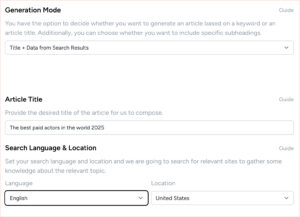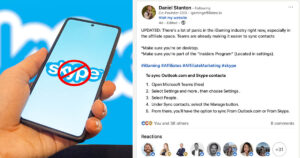In today’s digital age, we find ourselves constantly bombarded with promotional content, from subtle product placements in our favorite TV shows to overt advertisements on social media.
As marketers, the challenge of engaging our audience without disrupting their experience is ever-present. Enter ChatGPT, an innovative tool that’s transforming the way we create product placement content.
By leveraging the capabilities of advanced AI, we can seamlessly integrate products into narratives that resonate with our audience, making the marketing experience smoother and more organic.
Benefits of ChatGPT in Marketing:
- Simplifies the creative process
- Ensures messages are both impactful and unobtrusive
In this article, we will delve into:
- Practical applications of ChatGPT in our campaigns
- Benefits of integrating AI into marketing strategies
- The future of AI-driven marketing strategies
Join us as we navigate this exciting frontier, poised to redefine the intersection of technology and storytelling.
Benefits of using ChatGPT
One major benefit of using ChatGPT is its ability to generate personalized and engaging content for diverse audiences.
We know how important it is to connect with our community in meaningful ways, and ChatGPT helps us do just that. By customizing messages and stories, we can ensure that our audience feels seen and valued.
This personalized touch is essential for effective product placement and brand integration, making our promotional efforts more authentic and relatable.
When we use ChatGPT, we’re not just broadcasting a message; we’re building relationships.
It allows us to weave our products naturally into conversations, making them feel like a seamless part of the narrative. This approach not only captures attention but also fosters a sense of belonging among our audience.
We’re creating content that doesn’t just sell but resonates on a deeper level, enhancing our brand’s presence while staying true to our community’s values and interests.
With ChatGPT, our brand storytelling truly comes alive.
Understanding product placement strategies
To effectively weave our products into content, we need to master various product placement strategies.
Our first approach is subtlety; we want the product to feel like a natural part of the story, not an overt advertisement. This way, our audience feels connected and valued, not targeted.
Another strategy is brand integration, where the product plays a significant role in the content. Think of how a smartphone becomes a crucial tool for a character. By doing this, we make our brand indispensable to the plot, fostering a sense of belonging among our audience.
We can also use contextual placement, ensuring our product appears in settings that make sense and enhance realism.
For instance, a fitness tracker in a gym scene feels authentic and relatable.
ChatGPT can help us brainstorm and refine these strategies, making our product placement seamless and engaging.
By balancing these approaches, we create content that resonates and builds a loyal community around our brand.
How ChatGPT enhances product placement
Leveraging advanced AI capabilities
We can seamlessly integrate our products into content, making them feel like an essential part of the narrative. ChatGPT allows us to craft dialogues and scenarios where product placement is natural and engaging.
By tapping into the AI’s deep understanding of context and language, we make sure our brand doesn’t just appear in the story but becomes a meaningful part of it.
Creating Connection and Relevance
We all want to feel like we belong, and ChatGPT helps create that connection by weaving our products into conversations and settings that resonate with our audience.
It’s not just about visibility; it’s about relevance and relatability.
ChatGPT’s sophisticated algorithms ensure that our brand integration feels organic and not forced, enhancing the overall experience for the viewer or reader.
AI-Driven Adaptation and Personalization
This AI-driven approach means we can adapt and personalize content faster and more effectively, ensuring that our product placement is always on point, enhancing both engagement and affinity.
Leveraging ChatGPT for brand integration
With the power of AI, we can seamlessly weave our brand into diverse narratives, making it an integral and memorable part of the story.
Using ChatGPT, we achieve effective product placement by embedding our brand in a way that feels natural and engaging. This method allows us to foster a sense of belonging among our audience, who can see our products as part of their everyday lives.
ChatGPT helps us tailor content that resonates with our target demographic, ensuring that brand integration feels authentic.
We can create stories where our products are not just added extras but essential elements that enhance the narrative. Imagine reading a novel or watching a show where the brand appears at just the right moments, reinforcing its value without disrupting the flow.
By leveraging ChatGPT for brand integration, we make sure our products are not just seen but experienced.
This approach turns passive viewers into active participants who identify with the story and, by extension, our brand.
Crafting engaging product narratives
Crafting engaging product narratives allows us to captivate our audience and seamlessly introduce our brand into their everyday experiences.
By leveraging ChatGPT, we can create authentic stories that resonate deeply with our community, fostering a sense of belonging. These narratives aren’t just about mentioning a product; they’re about weaving our brand into relatable scenarios that our audience can see themselves in.
Let’s consider how we can use product placement effectively.
ChatGPT helps us integrate our products into conversations naturally, making them a part of the story rather than an interruption. This approach ensures that our audience feels a genuine connection to our brand.
By focusing on brand integration, we ensure that our products are seen as indispensable parts of our audience’s lives.
For instance, a character in a story using our product in a meaningful way can make our brand feel familiar and essential. With ChatGPT, we can tailor these narratives to align perfectly with our brand’s voice and values.
Implementing product mentions effectively
To implement product mentions effectively, we need to focus on seamlessly incorporating them into the narrative without disrupting the flow of the story. Our audience seeks connection and authenticity, so we must ensure our product placements feel like a natural part of the content. With ChatGPT, we can achieve this by carefully crafting dialogue and scenarios where the brand integration feels organic.
We should aim to avoid jarring or overly promotional mentions. Instead, let’s use subtle cues and contextual relevance to introduce products.
For instance, if a character is preparing for a long day, mentioning a specific brand of coffee they trust can create a sense of realism and trust without feeling forced.
By leveraging ChatGPT’s ability to understand and generate human-like text, we can weave product placements into conversations and settings that resonate with our audience.
This way, our brand integration becomes a part of the narrative’s fabric, fostering a sense of belonging and authenticity.
ChatGPT for seamless brand promotion
To seamlessly promote brands, we can harness ChatGPT’s natural language capabilities to create engaging and authentic content that resonates with our audience.
By utilizing ChatGPT for product placement, we ensure that brand mentions feel natural and integrated into the narrative. This approach fosters a sense of community and trust among our audience, as they perceive the content as genuine rather than forced.
Our goal is to achieve brand integration that aligns perfectly with the story we’re telling. ChatGPT helps us craft dialogues and scenarios where products are part of the conversation, not just an add-on. This technique makes the audience feel like they’re part of an inclusive group where shared experiences and common interests revolve around the brands we promote.
By strategically embedding brand mentions within the content, we can create a seamless blend of storytelling and promotion. This method not only enhances the authenticity of our message but also strengthens our connection with the audience, making them feel valued and understood.
Enhancing viewer engagement with product placement
We can boost viewer engagement by strategically weaving brand mentions into compelling narratives that capture and hold their attention.
When we use ChatGPT to craft these narratives, we ensure the product placement feels natural and integral to the storyline. This approach not only highlights the brand but also resonates with our audience on a personal level.
ChatGPT allows us to seamlessly integrate products in ways that don’t disrupt the viewing experience. For example, we can:
- Insert a brand into a character’s daily routine
- Include the brand in a pivotal scene
This makes the product feel like a part of their world. This kind of brand integration fosters a sense of belonging among viewers, who see these products as part of a shared experience.
By leveraging ChatGPT’s capabilities, we create stories where the brand is a character in its own right.
This method of product placement enhances viewer engagement, ensuring they connect with both the narrative and the brand in a meaningful way.
ChatGPT for targeted audience reach
Leveraging AI-driven insights, we can precisely tailor our narratives to resonate with specific audience segments, ensuring our message hits the mark every time.
ChatGPT allows us to craft content that feels personalized and speaks directly to the hearts of our target audience, making them feel seen and understood.
In the realm of product placement, this means we’re not just showcasing products; we’re seamlessly integrating brands into stories that matter to our viewers.
By understanding audience preferences and behaviors, ChatGPT empowers us to create brand integration that feels natural and relevant.
This isn’t just about fitting a product into a scene; it’s about weaving it into the narrative in a way that enhances the story and builds a deeper connection with our audience.
Our viewers feel a sense of belonging when they see products that align with their values and interests, making our brand integration efforts more impactful and meaningful.
Key benefits include:
- Enhanced storytelling
- Deeper audience connection
- Increased brand relevance
By leveraging these insights, we can ensure that our brand integration is not only effective but also resonates on a deeper level with our audience.
Amplifying brand visibility through ChatGPT
Leveraging AI-driven content creation, we can significantly amplify brand visibility by ensuring our messages are both captivating and strategically placed.
ChatGPT allows us to seamlessly weave product placement into engaging narratives that resonate with our audience. By integrating brands naturally into our content, we can create a sense of community and belonging among our readers.
Imagine the power of brand integration when ChatGPT crafts a story where the product isn’t just a prop, but an essential part of the narrative. This subtle yet effective method ensures that the brand stays top-of-mind without feeling intrusive.
It’s about making the product a relatable part of the audience’s everyday life.
By using ChatGPT, we can tailor our product placement to fit various contexts, ensuring our brand messages are relevant and engaging. This personalized approach not only boosts visibility but also fosters a deeper connection with our audience.
Together, we can create content that:
- Informs
- Inspires loyalty
- Builds trust
Creating authentic product experiences
We can create authentic product experiences by embedding products into stories that genuinely reflect our audience’s lifestyle and values. By leveraging ChatGPT, we can craft narratives where product placement feels natural and relatable.
Imagine a story where friends gather for a cozy movie night, and the brand of snacks they share isn’t just a product but part of the experience we all cherish.
ChatGPT helps us seamlessly integrate these brand elements, ensuring they resonate with our audience’s sense of belonging. It’s not just about mentioning a product; it’s about weaving it into moments that matter.
Through thoughtful brand integration, we can highlight how these products enhance everyday life, mirroring our audience’s aspirations and experiences.
When we use ChatGPT for product placement, we build connections that feel genuine. We’re not just selling a product; we’re sharing a story where the brand plays a meaningful role.
This approach fosters a deeper bond between the brand and our community.
Measuring success of product placements with ChatGPT
To gauge the effectiveness of our product placements with ChatGPT, we need to analyze key performance metrics and audience engagement data.
By tracking how often users interact with specific products and how naturally these integrations flow within the conversation, we can measure the success of our brand integration efforts.
Let’s look at:
- Click-through rates
- Time spent discussing the product
- User sentiment
These metrics give us a clear picture of how well the product placement resonates with our audience.
Additionally, we should monitor feedback through:
- Direct comments
- Social media mentions
These help us understand the broader impact.
We’re all in this together, aiming for authentic experiences that feel more like recommendations from a friend than a sales pitch. When we see high engagement and positive sentiment, it means we’re hitting the mark.
Our goal is to create seamless brand integrations that enhance the user experience without feeling intrusive. With ChatGPT, we can continually refine our approach to ensure we’re truly connecting with our community.
ChatGPT for dynamic product storytelling
Leveraging the conversational nature of ChatGPT, we can craft dynamic product stories that captivate and engage our audience.
Through seamless brand integration, we transform mere product placement into an immersive narrative experience.
Picture this:
- Instead of a static mention, our product becomes a vital character in a compelling story
- Engaging our community on a deeper level
ChatGPT allows us to create dialogues that naturally weave products into the plot, making the brand feel like a seamless part of the story.
This approach fosters a sense of belonging among our audience, as they experience the product within a context they care about.
By doing so, we don’t just advertise; we build relationships and trust.
Our audience craves content that feels personal and relevant.
With ChatGPT, we can dynamically tailor stories to individual preferences, ensuring each interaction feels unique and meaningful.
This isn’t just storytelling; it’s creating a shared journey that resonates deeply with our community.
Future of product placement with ChatGPT
As we look ahead, the future of embedding products within narratives promises to be even more innovative and interactive with the continuous advancements in ChatGPT technology.
We’re on the brink of a new era where brand integration will seamlessly blend into our storytelling, creating experiences that feel more authentic and engaging.
Imagine a world where ChatGPT doesn’t just insert a product into a conversation but weaves it into the fabric of the narrative, making it a natural part of the story. This level of product placement can help brands connect with audiences on a deeper level, fostering a sense of belonging and loyalty.
With ChatGPT’s ability to understand and generate contextually relevant content, we can expect product placement to evolve into a more collaborative and immersive experience. Brands will no longer just be sponsors; they’ll become integral characters in the stories we love.
Together, we’re shaping a future where technology and storytelling converge, creating richer, more meaningful connections.





